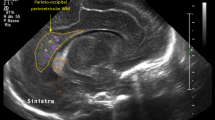Abstract
Background
Resistivity index (RI) of the pericallosal artery as is commonly measured during head ultrasound (US) examination in neonates. Some studies have shown that RI measured with gentle compression of the fontanelle provides additional information in cases of neonatal brain anomalies.
Objective
The purpose of this study was to establish normal RI values with and without compression in a large population of neonates with normal cranial ultrasound as a function of gestational age.
Materials and methods
The authors of this retrospective study reviewed the RI of 323 infants with normal gray-scale cranial US and with a gestational age ranging 26–42 weeks. We conducted the exams both with and without compression of the anterior fontanelle and we studied changes in RI depending on gestational age, gender and type of delivery.
Results
Infants with a gestational age of more than 35 weeks tended to have a lower RI (P=0.011). The compression of the anterior fontanelle emphasized the change in RI with increasing gestational age, with higher gestational ages having a lower RI (P<0.001). The results concerning the percentage change between baseline RI and RI with compression showed that infants with higher gestational ages have a smaller percentage change in RI (P=0.002).
Conclusion
We established the normal values for RI from 26 weeks to 42 weeks of gestation. The results of the study show the importance of taking the gestational age into consideration when evaluating the RI.





Similar content being viewed by others
References
Couture A, Veyrac C, Baud C et al (2001) Advanced cranial ultrasound: transfontanellar Doppler imaging in neonates. Eur Radiol 11:2399–2410
Zamora C, Tekes A, Alqahtani E et al (2014) Variability of resistive indices in the anterior cerebral artery during fontanel compression in preterm and term neonates measured by transcranial duplex sonography. J Perinatol 34:306–310
Horgan JG, Rumack CM, Hay T et al (1989) Absolute intracranial blood-flow velocities evaluated by duplex Doppler sonography in asymptomatic preterm and term neonates. AJR Am J Roentgenol 152:1059–1064
Taylor GA, Madsen JR (1996) Neonatal hydrocephalus: hemodynamic response to Fontanelle compression — correlation with intracranial pressure and need for shunt placement. Radiology 201:685–689
Taylor GA (1992) Effect of scanning pressure on intracranial hemodynamics during transfontanellar duplex US. Radiology 185:763–766
Taylor GA, Phillips MD, Ichord RN et al (1994) Intracranial compliance in infants: evaluation with Doppler US. Radiology 191:787–791
Zamora CA, Oshmyansky A, Bembea M et al (2016) Resistive index variability in anterior cerebral artery measurements during daily transcranial duplex sonography: a predictor of cerebrovascular complications in infants undergoing extracorporeal membrane oxygenation? J Ultrasound Med 35:2459–2465
Pinto PS, Tekes A, Singhi S et al (2012) White-gray matter echogenicity ratio and resistive index: sonographic bedside markers of cerebral hypoxic-ischemic injury/edema? J Perinatol 32:448–453
Blankenberg FG, Loh NN, Norbash AM et al (1997) Impaired cerebrovascular autoregulation after hypoxic-ischemic injury in extremely low-birth-weight neonates: detection with power and pulsed wave Doppler US. Radiology 205:563–568
Gerner GJ, Burton VJ, Poretti A et al (2016) Transfontanellar duplex brain ultrasonography resistive indices as a prognostic tool in neonatal hypoxic-ischemic encephalopathy before and after treatment with therapeutic hypothermia. J Perinatol 36:202–206
Bland JM, Altman DG (1986) Statistical methods for assessing agreement between two methods of clinical measurement. Lancet 1:307–310
Taylor GA, Short BL, Walker LK, Traystman RJ (1990) Intracranial blood flow: quantification with duplex Doppler and color Doppler flow US. Radiology 176:231–236
Liu J, Cao H-Y, Huang X-H, Wang Q (2007) The pattern and early diagnostic value of Doppler ultrasound for neonatal hypoxic-ischemic encephalopathy. J Trop Pediatr 53:351–354
Boylan GB, Young K, Panerai RB et al (2000) Dynamic cerebral autoregulation in sick newborn infants. Pediatr Res 48:12–17
Zamora IJ, Sheikh F, Cassady CI et al (2014) Fetal MRI lung volumes are predictive of perinatal outcomes in fetuses with congenital lung masses. J Pediatr Surg 49:853–858
Author information
Authors and Affiliations
Corresponding author
Ethics declarations
Conflicts of interest
None
Additional information
Publisher’s note
Springer Nature remains neutral with regard to jurisdictional claims in published maps and institutional affiliations.
Rights and permissions
About this article
Cite this article
Elmfors, A.F., Sandgren, T., Ford, K. et al. Normal values of the resistivity index of the pericallosal artery with and without compression of the anterior fontanelle. Pediatr Radiol 49, 646–651 (2019). https://doi.org/10.1007/s00247-019-04347-y
Received:
Revised:
Accepted:
Published:
Issue Date:
DOI: https://doi.org/10.1007/s00247-019-04347-y




